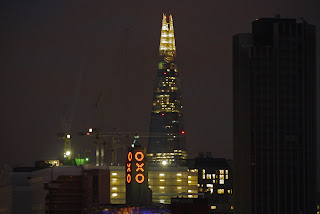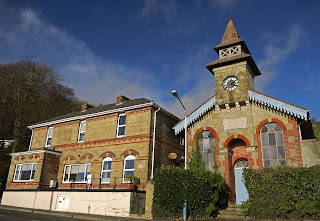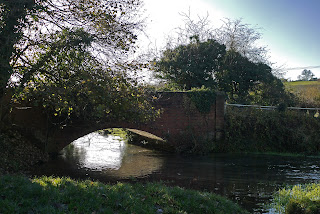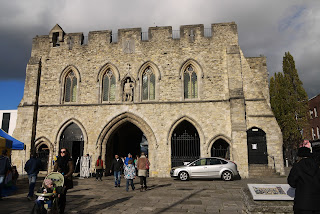Abbey House, Baker St
We were staying near Baker St so we started the walk there with a quick look at Abbey House. It dates from the 1920s and the architect was John James Joass. The tower brings to mind the work of Lutyens. The building has more recently been redeveloped as luxury apartments and only the facade is original.
An amusing sidelight is that Abbey House is located at 219-229 Baker St and of course 221B is the celebrated address of Sherlock Homes - although the numbers, and presumably the street, did not extend that far when Conan Doyle wrote his stories. For many years Abbey National apparently had an employee whose sole job was to respond to letters addressed to Holmes. Nowadays, there is a blue plaque at the Sherlock Holmes museum further up the road at 237-241. I have to confess that I can't get my head around the idea of a museum to a fictional character.
It being Angela's birthday, we then went to one of the several hotels which have strong art deco links. Breakfast at Claridges was a memorable way to start the day. The entry lobby has fine mirrors, Lalique statues and Egyptian pilasters.
We now undertook the first of two cheats and took the tube to Mornington Crescent to see the former Carreras tobacco factory, now refurbished as offices, Greater London House. The building was erected in 1926-28 and was the work of architects M.E and O.H Collins and A.G Porri. It has a strong Egyptian theme, highly fashionable at the time, four years after the discovery of the tomb of Tutankamun.
A close-up reveals the cat theme - there are also two large cats standing guard at the entrance. This had a double meaning: the Egyptian god Bast and also a brand image used on packs of Craven A cigarettes.
From here, we walked down Hampstead Road, right into Euston Road, and left into Portland Place (via Park Crescent), passing John Nash's famous terraces on the way. Our first destination was the RIBA building (1932-4, by G Grey Wornum).
One of the great things about this building is that it is an open space with a library, bookshop and cafe available to all. So, unlike all the others on this tour you can go inside and look around the interior. It proves to be notably spacious and well-proportioned, with wonderful etched glass in geometric patterns and delightful mouldings on many of the ceilings, echoing the extensive external sculpture.
Further down Portland Place is Broadcasting House of 1931-2 - note the miniature radio mast on the roof. The architects were Myer and Watson-Hart. The sculpture of Prospero and Ariel over the main entrance is by Eric Gill.
There are other relief sculptures over the lesser doors. This one is Ariel between Wisdom and Gaiety, also by Eric Gill.
Just next door is All Souls church. It's not art deco obviously, but I am including it because it is a fine London sight which I have ignorantly walked past many times. It dates from 1834 and is the only church designed by the great residential architect John Nash.
The porch and tower are a great composition, but the rectangular nave and two aisles now feel more like a concert hall than a church.
Now we walked down to Oxford Circus and straight across into Regent Street, taking second left into Great Marlborough St. There on the corner of Argyll St is one of London's most wonderful - and probably least known - art deco buildings, the fabulous Ideal House (now known as Palladium House). I have walked underneath this building numerous times, heading away from Oxford Circus tube station, unaware of its existence.
Pevsner is quite scathing about it and the near-contemporary Liberty building opposite: "the traveller will stop and consider which of two evils of our present civilisation he may be readier to put up with". He describes Ideal House as a "piece of commercial showmanship". The architects were Raymond Hood and G Jeeves and it dates from 1928.
After a break for an excellent lunch at Fishworks in nearby Swallow Street we resorted to the tube again to go to Barbican. We then walked to Charterhouse Square to see the curving lines of Florin Court. It was built in 1936 and designed by Guy Morgan and Partners. It was notable for its roof garden and basement swimming pool.
It wasn't until I researched this walk that I realised why the square is so called. In the opposite corner is Sutton’s Hospital in Charterhouse. This former Carthusian priory (established 1371), became a private house after the Dissolution of the monasteries but in 1611 it was sold to Thomas Sutton who
endowed a charitable foundation to educate boys and care for elderly men. Charterhouse school was relocated in Surrey in 1871, but the almhouses continue in operation.
The next building was supposed to be
Chambers and Co at 23 Long Lane, but I was distressed to find that it
had been knocked down as part of the construction of Crossrail. There is
an image of what it looked like here.
We continued past Smithfield market (Horace Jones, 1868) ...
... and took a circuitous route to Ludgate Circus to begin the final stage of the walk, along Fleet St.
At 120 there is the wonderful former Daily Express building, now Goldman Sachs. It was designed by Ellis & Clarke, in collaboration with Sir Owen Williams. It seems remarkably modern and Pevsner says that "it was certainly a daring design at the time".
A few doors away, at 135-141 is the more classically influenced Daily Telegraph building (also Goldman Sachs). It is the work of Elcock & Sutcliffe, assisted by Thomas Tate and dates from 1928. It was too dark by now to get a good photo, but there are some nice art deco details and a celebrated clock. Pevsner is not impressed however, writing that it has "little to recommend it". It is extraordinary that two such different buildings could be near contemporaries - and the same point could be made about Ideal House and Liberty's.
As we reached Waterloo Bridge, we made a short detour to snatch a glimpse at the Oxo Tower, with the Shard pleasingly in the background.
After all this, the only way to finish seemed to be at another art deco hotel, the Savoy, where we joined the throng for a drink in the American Bar.
Distance: maybe 5 miles.
Conditions: cold but bright.
Rating: four and half stars.




























































